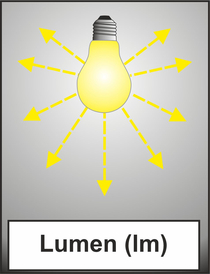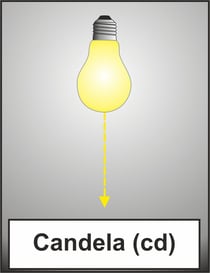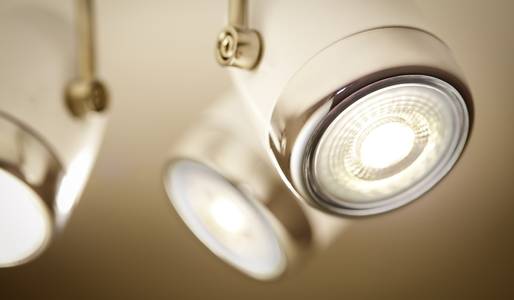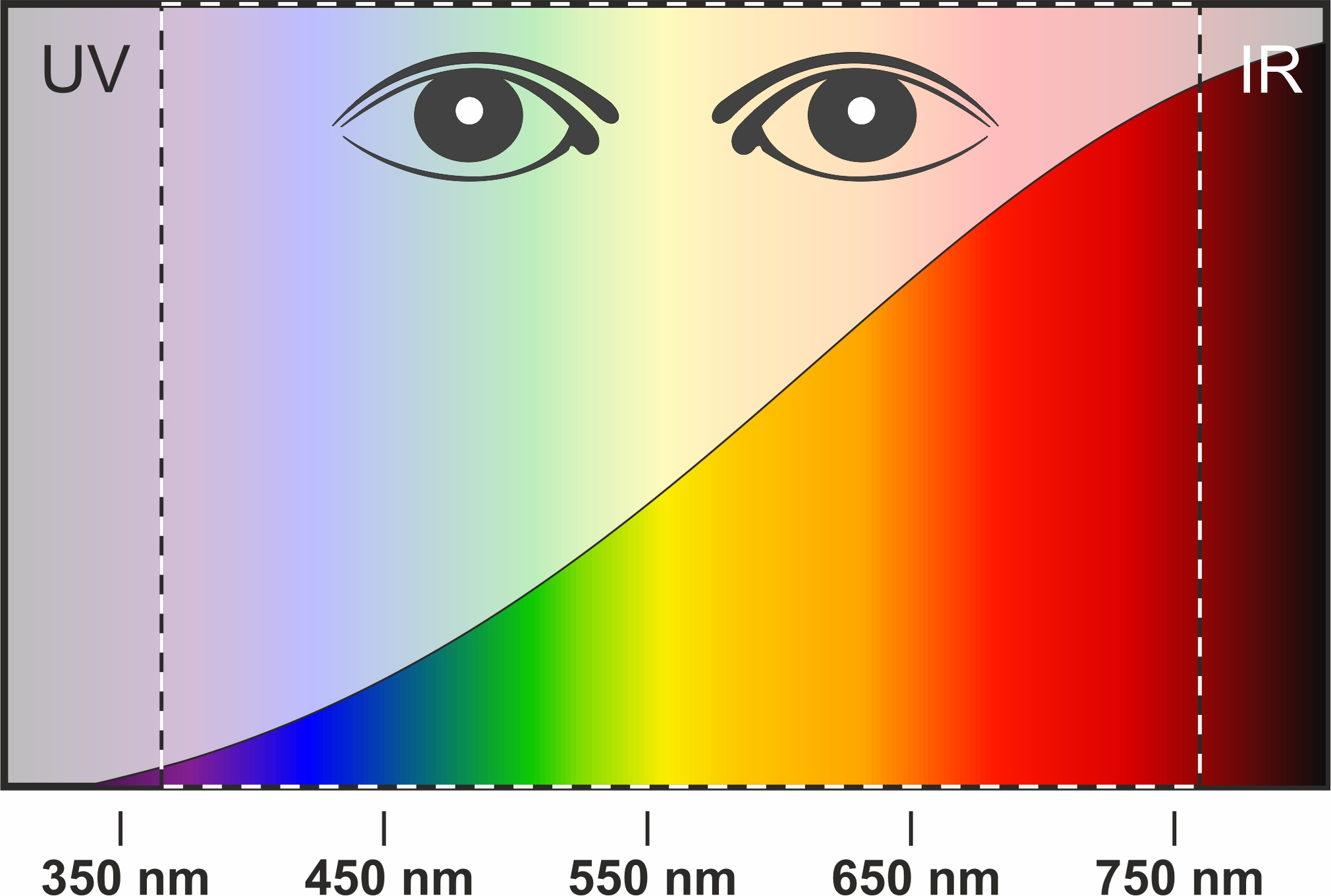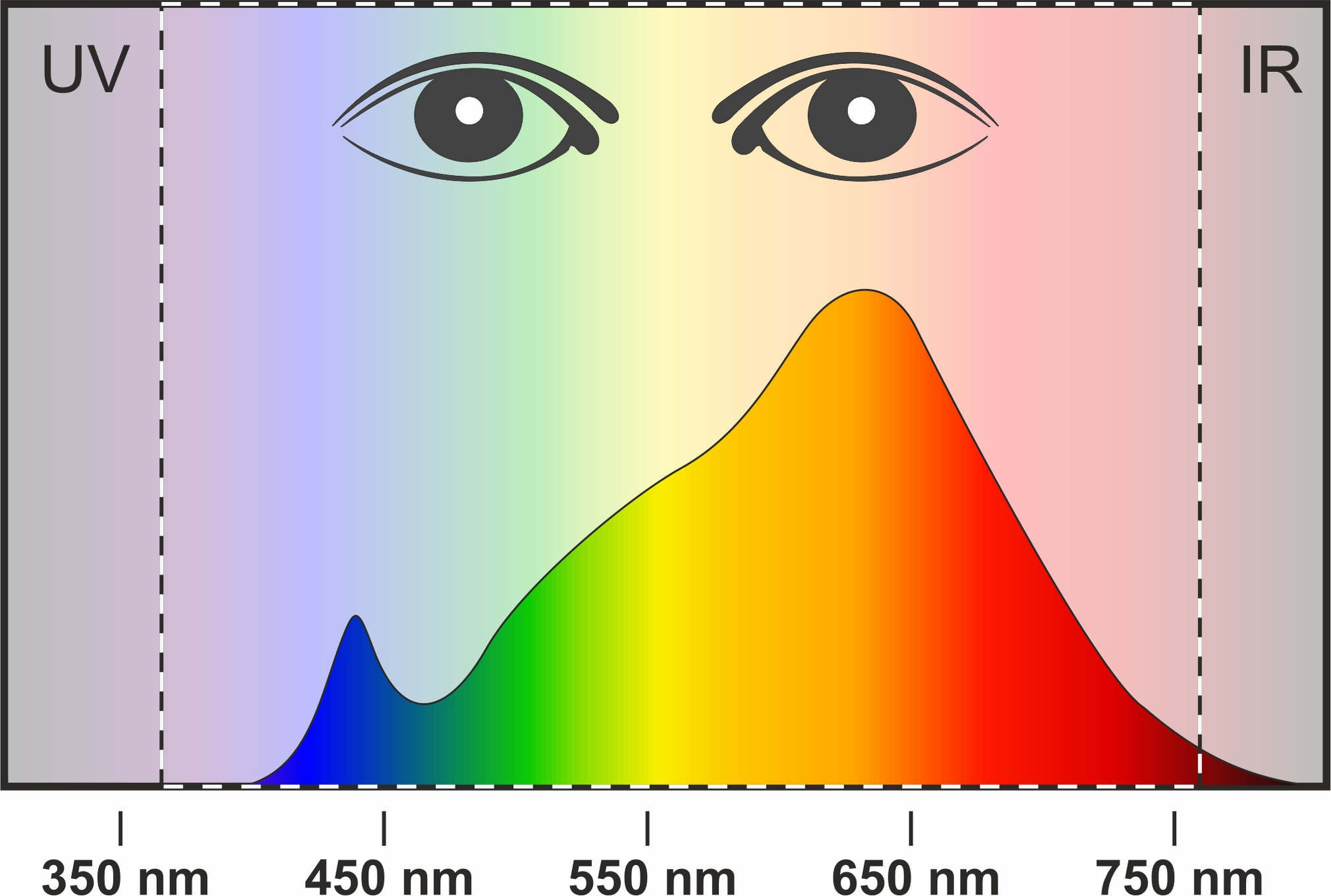Lighting technology » Technical lighting terms and their meaning
Updated: 02/27/2024 | Reading time: 10 minutes
This text is machine translated.
Light is an important topic, especially in the darker months of the year. This applies both in the workplace and at home. But not all light is the same. There are sometimes considerable differences and the result of lighting is not always what the people concerned imagined in advance or during planning.
To avoid this, manufacturers and retailers go to great lengths to precisely describe the properties of the respective lamps and light sources in the product claims and technical data. Unfortunately, different technical terms are used, which sometimes confuse more than they help. Or it is absolutely unclear what exactly is meant by a specification such as RA < 95.
That's why we decided to shed some light on the subject and take a closer look at some of the basic concepts of lighting technology.
Light is an electromagnetic radiation with a specific frequency range that can be perceived by the human eye. Electromagnetic radiation is a spatially propagating oscillation (wave) consisting of coupled electric and magnetic fields. This includes radio waves, microwaves, thermal radiation, light, X-rays and gamma radiation.
In contrast to sound waves, which can only propagate with the help of air, electromagnetic waves do not require a medium. This is why they can also propagate in a vacuum and the light from the sun can reach us on earth.
Electromagnetic waves can have a very wide frequency spectrum. The frequency indicates how often a signal oscillates back and forth per second. In the visible spectrum of electromagnetic radiation, the frequency is around 384 to 789 teraherz (THz). One teraherz corresponds to 1 x 1012 or 1,000,000,000,000 oscillations per second.
As electromagnetic waves, and therefore also light, travel at almost 300,000 km per second, the wavelength can be derived from the frequency. At 300,000 oscillations per second (Hz), the wavelength would be around 1 km long. Due to the extremely high frequency, the wavelength of visible light is between 380 and 780 nanometers (nm). A nanometer is the thousandth part of a micrometer (µm), which in turn is the thousandth part of a millimeter (mm). A nanometer is therefore the billionth part of a meter (1nm = 10-9 m).
Depending on the wavelength of the electrical radiation, the human eye perceives different colors. The lower limit of visible light, i.e. the oscillation with the lowest wavelength and the highest frequency, is 380 nm or 789 THz. For the human eye, this is the color violet. The upper limit is 780 nm or 384 THz and corresponds to the color red. The other spectral colors perceived by the human eye lie between the two limits mentioned. The only difference between the various colors is the wavelength.
| Color | Wavelength range | Frequency range |
|---|---|---|
| Purple | 380 nm - 420 nm | 789 THz - 714 THz |
| Blue | 420 nm - 490 nm | 714 THz - 612 THz |
| Green | 490 nm - 575 nm | 612 THz - 521 THz |
| Yellow | 575 nm – 585 nm | 521 THz - 512 THz |
| Orange | 585 nm - 650 nm | 512 THz - 461 THz |
| Red | 650 nm - 780 nm | 461 THz - 384 THz |
The radiation emitted by the sun has its greatest intensity in the visible light range. However, the proportions of the different frequencies and therefore also the light colors vary in intensity. The reason for this is that solar radiation is absorbed to a greater or lesser extent by the atmosphere, depending on the wavelength of the individual frequency components.
This effect is also dependent on the current weather and, of course, the position of the sun, i.e. the angle at which the rays of light enter the atmosphere. As a result, the color spectrum of sunlight changes continuously.
As already shown, the color perceived by the human eye changes with the wavelength of the light. If you take a closer look at the tables and graphs above, you will notice that there is no white light.
This is because white light (WL) is a frequency mixture of waves with different wavelengths.
This can be checked very easily if white sunlight falls on a prism and thus splits into its various spectral colors, as in a rainbow.
But even the white light of the sun is not always perceived as white. This is because sunlight can vary depending on the position of the sun and then appears bluish, orange or reddish. A candle or a light bulb, on the other hand, do not emit pure white light, but rather a yellowish light. To determine whether a white light source emits more bluish or more yellowish light, the color temperature is specified in Kelvin (K) in the technical data. The scaling for °C and K is identical, except that 0 Kelvin corresponds to the absolute zero point of -273.15 °C. The freezing point of water is therefore 0 °C or 273.15 K. The assignment of which color corresponds to a certain Kelvin temperature is based on the Plank radiator. This is a deep black hollow body with an opening, which itself becomes a radiator when heated. As the temperature of the hollow body increases, the color of the radiation emitted through the opening changes from red to yellow and white to blue.
Important:
The color temperature of a light source therefore indicates whether the white light is colored and, if so, in what hue. However, the color temperature of the light says nothing about the actual ambient temperature in °C. It merely describes the subjectively perceived warmth or coldness of the light.
Color temperature scale
Reddish or orange light tends to have a warm effect and bluish light is perceived as cold. The color tone of white light therefore also has a lot to do with people's well-being.
It is therefore important that the color temperature of the light in the living area and working environment is right:
In living and dining areas, the value should be 2,700 K or 3,000 K. In restaurants, extra warm white luminaires with 2,300 K or 2,500 K are often used to create a cozy atmosphere.
In public areas and workplaces, the color temperature should be 4,000 K or 5,000 K. In warehouses and workshops, luminaires with 6,500 K are perfect.
Light sources and their color temperatures
| Light source | Color temperature |
|---|---|
| Candle | 1,500 K |
| Incandescent lamp | 2,600 K to 2,800 K |
| Halogen lamp | 3,200 K |
| Fluorescent tube Warm white or white | 3,200 K or 4,000 K |
| Morning sun or afternoon sun | 3,000 K or 5,500 K |
| Overcast sky | 6,500 K or 7,000 K |
| Blue hour | 9,000 K or 12,000 K |
The luminous flux is the visible light output per unit of time that a light source emits. The brighter the light, the higher the luminous flux or luminosity. Luminous flux is expressed in lumens (lm) and is a photometric quantity.
Photometric quantities describe the visible light according to the brightness perception of the human eye.
Years ago, when powerful incandescent lamps were still commercially available, the watt specification was an understandable indication of the expected brightness of the light source. However, since light-emitting diodes have become established as light sources, the lumen specification has increasingly become the focus of prospective buyers.
Important:
The lumen specification must always be considered in conjunction with the beam angle. The beam angle is given in degrees and describes how large the light cone of a lamp or light source is. If an incandescent bulb and a reflector light source with the same number of lumens are compared, the incandescent bulb appears significantly dimmer in terms of luminosity. This is because an incandescent bulb distributes the light almost spherically, whereas the reflector light source concentrates the entire light output in one direction. In this case, the intensity or luminous intensity is significantly higher with the reflector light source.
The luminous intensity indicates how large the luminous flux is in relation to a specific solid angle. Luminous intensity is also a photometric quantity and is specified in candela (cd).
As already mentioned, the intensity of the light depends on the beam angle. However, the three-dimensional solid angle rather than the two-dimensional beam angle is used to describe the luminous intensity.
The solid angle is specified in steradian and thus represents the spatial variant of the beam angle. For a sphere with a radius of 1 m, a solid angle of one steradian at the top of the sphere results in an area of 1 m².
Practical example:
A burning candle corresponds to a light source with a luminous flux of 12 lumens. Due to the spherical light distribution (4π steradian), this results in a luminous intensity of around one candela.
If a reflector/focus device with an aperture angle of just 5° (0.006 steradian) is placed over the flame, the luminous intensity of the focused light increases to approx. 2000 candela. In practice, the luminous intensity is usually not specified for the light sources, as this always depends on the luminous flux and the solid angle of the light source.
Illuminance lux (lx) is also a photometric quantity and indicates how much luminous flux or lumen from a light source is incident on a certain surface. Basically, the further away the surface is from the light source, the lower the illuminance. An illuminance of one lux is achieved when a luminous flux of one lumen is incident on an area of one square meter.
As illuminance always depends on the spatial conditions, it is not specified for light sources or lamps. However, there are recommendations as to how high the illuminance should be in different areas or situations.
Important!
In addition to illuminance, the color temperature of the light must also be right.
| In living areas | 50 - 200 lux |
| At office workstations | 50 - 200 lux |
| In print shops, doctors' rooms and test laboratories | 1,000 - 2,000 lux |
| For dental treatment | 1,000 - 5,000 lux |
| Overcast sky | 5,000 - 10,000 lux |
| Operation fields in medicine | 10,00 - 100,000 lux |
| Midday sunlight on a clear day | approx. 100,000 lux |
Luminance describes the impression of brightness emanating from a uniformly illuminated surface and is expressed in candelas per square meter (cd/m2). Luminance is therefore the most suitable of all photometric quantities for describing the sensory impression perceived by the human eye.
Of course, the properties of the illuminated surface also play a major role. Dark surfaces appear significantly darker than bright surfaces, even if they are illuminated with the same luminous intensity.
In the case of panel lights or panel luminaires, the luminance could describe the properties of the luminaire far better than simply stating the luminous intensity. For point light sources, luminous intensity is a better indicator.
| Full moon night | 0.1 cd/m² |
| LC display with black surface | 0.15 to 0.8 cd/m² |
| LC display with white surface | 150 to 500 cd/m² |
| Overcast sky | 2,000 cd/m² |
| Clear sky | 8,000 cd/m² |
| 60 W incandescent lamp (matt) | 120,000 cd/m² |
| Sun disk at noon | 1,600,000,000 cd/m² |
The luminous efficacy describes the efficiency of light sources. In other words, how much energy is required to generate a certain luminous flux.
The figures are given in lumens per watt (lm/W). The higher the value, the more efficient the light source.
Incandescent light bulbs have been used for lighting for many decades, although they were actually totally uneconomical. This is because conventional light bulbs only convert around 5% of the electricity into light. The remaining energy is emitted as heat.
The LEDs now used are already much more efficient.
| Incandescent lamp | 20 lm/W |
| Halogen lamp | 30 lm/W |
| Energy-saving lamp | 86 lm/W |
| Fluorescent tube | 105 lm/W |
| LED light source | 180 lm/W |
Important:
When assessing the efficiency of a light source, the entire system consisting of light source, luminaire, optics and ballasts must always be considered in practice.
It often happens that colorful textiles or fresh fruit shine in the most amazing colors in the store and then strangely no longer look as colorful at home. When this happens, it is not due to the quality of the products, but to a poor color rendering index of the domestic lighting. The color rendering index provides information on how naturally the colors of objects are perceived.
The color rendering index is indicated on the packaging of light sources as an RA value (general reference index) or CRI value (color rendering index).
In addition, no physical units are given, only numbers (1 to 100). The higher the value, the better the color rendering.
In the past, the color rendering index was not an issue because incandescent lamps, like sunlight, have an RA value of 100.
The first LED light sources, on the other hand, had a really poor RA value, but thanks to continuous further development, this is now over 95. Energy-saving lamps are in the 80 - 89 range, fluorescent lamps at 60 - 90 and sodium vapor lamps only achieve 30 - 40.
For millions of years, the natural light of the sun has been the essential basis for the diversity of life as we know it today on our planet. The sun's light provides the necessary brightness during the day and, thanks to its broad light spectrum, enables a wide variety of colors. The short-wave IR radiation of sunlight also ensures a pleasant warmth on the skin and the long-wave UV-B radiation supports the formation of vitamin D in humans. This is why most people feel really good on a sunny day. Even if it falls on a cold winter month.
In contrast, artificial light sources are primarily used to provide the necessary brightness in a wide variety of places. For decades, light bulbs, halogen lamps, fluorescent tubes and energy-saving lamps were the measure of all things. However, the light emitted by these light sources did not correspond to the actual spectrum of sunlight.
In the meantime, these long-established light sources, which are still in use, are increasingly being replaced by LEDs. LEDs are light-emitting diodes, the function of which we have described in detail in our LED guide. Huge advances in LED technology in the past have meant that these energy-saving light sources are now extremely bright and can also emit a light spectrum with a high blue component. This means that lighting similar to daylight is now also possible with LED light sources.
Variety of colors thanks to RGB LEDs
Another advantage is the additive color mixing of LEDs with different colors. With so-called RGB LEDs, which are able to emit light in the primary colors red, green and blue, a wide variety of colors can be created for individual lighting through targeted control. The right light color with the required intensity for every mood, so to speak.
But even if artificial light sources are becoming better, more effective and more energy-efficient, you should think carefully about whether it is absolutely necessary to turn night into day by force. Apart from the ever-increasing light pollution, the sun is an important clock for the biorhythm of many plants and creatures, clearly defining the phases of activity and rest.







